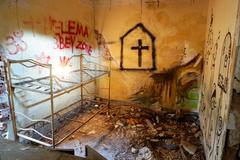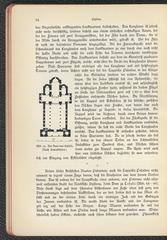
Sanctuary of Gibilmanna Visiting Hours, Tickets, and Travel Guide: Cefalù Historical Sites
Date: 04/07/2025
Introduction
Perched at 800 meters above sea level on the verdant slopes of Pizzo Sant’Angelo in Sicily’s Madonie mountain range, the Sanctuary of Gibilmanna is one of the island’s most ancient and revered Marian shrines. This guide explores the sanctuary’s historical roots, artistic treasures, cultural significance, and provides up-to-date information on visiting hours, ticket policies, accessibility, and travel tips. Whether you are a pilgrim, history buff, or a traveler in search of Sicily’s hidden gems, Gibilmanna promises a profound and memorable experience (Viva Sicilia; Visit Gratteri).
Table of Contents
- Introduction
- Historical Overview
- Architectural and Artistic Heritage
- Religious Significance and Pilgrimage
- Visiting Hours, Tickets, and Accessibility
- Getting There and Travel Tips
- Nearby Attractions
- Notable Events and Community Traditions
- Practical Visitor Information
- Frequently Asked Questions (FAQ)
- Summary and Recommendations
- References
Historical Overview
Origins and Early History
The Sanctuary of Gibilmanna’s origins are rooted in the 6th century, traditionally linked to Pope Gregory the Great, who is said to have commissioned six Benedictine monasteries across Sicily, including Gibilmanna (Wikipedia). Its name, from Arabic “Gibel el Iman”—meaning “Mount of Faith”—reflects Sicily’s multicultural history, blending Byzantine, Arabic, and Norman influences (Viva Sicilia). Initially, the site served as a Benedictine monastery, later abandoned during the Arab conquest but revived under Norman rule.
Medieval to Renaissance Transformations
By the 12th and 13th centuries, the sanctuary was recognized as a religious site, with Marian devotion becoming central. In 1535, Capuchin friars assumed stewardship, initiating significant architectural and artistic developments. The arrival of the revered Madonna and Child statue—attributed to Antonello Gagini or his school—in 1534, marked a pivotal moment for the sanctuary’s spiritual and cultural identity (Cefalunews).
Architectural and Artistic Heritage
The Sanctuary Church
The church’s architecture blends Romanesque, Gothic, and Baroque elements, with its most significant expansion occurring in the 17th century. Key highlights include:
- Marble Madonna and Child (1534): The sanctuary’s focal point, attributed to Antonello Gagini, a masterpiece of Sicilian Renaissance art (Enjoy Sicilia).
- Baroque Marble Altar: Crafted by Baldassare Pampillonia and designed by Paolo Amato, originally intended for Palermo Cathedral (Viva Sicilia).
- Other Artworks: Byzantine crucifix, triptychs, and sculptures by local artists, reflecting centuries of devotion.
The Neo-Gothic façade, completed in 1907, and the adjoining sacristy and portico enhance the sanctuary’s picturesque setting (Wonders of Sicily).
The Convent and Museum
The Capuchin convent, established in the 16th century, remains integral to the sanctuary complex. The on-site museum displays sacred relics, liturgical objects, vestments, and rare manuscripts, offering insight into the region’s spiritual and artistic legacy (Cultural Heritage Online).
Religious Significance and Pilgrimage
Dedicated to Maria Santissima di Gibilmanna, the sanctuary draws thousands of pilgrims, especially during the annual feast on September 8th (Nativity of Mary). The site is renowned for its traditions of Marian devotion, spiritual retreats, and community events that reinforce its central role in local religious life (Cefalunews).
The 1954 Marian Year “peregrinatio” further cemented the Madonna of Gibilmanna as the patroness of the Diocese of Cefalù, with her effigy touring all parishes before returning in a grand celebration (Cefalunews).
Visiting Hours, Tickets, and Accessibility
- Opening Hours: Generally open daily from 8:00 AM to 7:00 PM. Hours may be adjusted during religious festivals or special events; always check ahead for updates (Trek Zone).
- Admission: Entry is free. Donations are encouraged to support maintenance and charitable efforts.
- Guided Tours: Available by arrangement through local tour operators or the sanctuary’s visitor center, providing deeper historical and artistic context.
- Accessibility: The sanctuary is partially accessible. Main areas have ramps, but some sections (museum, picnic grounds) have uneven terrain—advance inquiry is recommended for visitors with reduced mobility.
Getting There and Travel Tips
- By Car: From Cefalù, follow the SP54 provincial road for about 15 km (25–30 minutes). Free parking is available on site.
- By Public Transport: No direct bus service; taxis or guided tours are recommended.
- On Foot/Bike: Adventurous visitors can hike or cycle from Cefalù, with marked trails available. The ascent is strenuous and best suited for experienced hikers (Italiaguida).
- Best Times to Visit: Spring and early autumn offer pleasant temperatures and rich natural scenery. The September 8th feast is the most vibrant, though also the busiest.
Nearby Attractions
Enhance your visit by exploring these notable sites:
- Cefalù Cathedral: A UNESCO World Heritage site showcasing Arab-Norman architecture (Italiaguida).
- Rocca di Cefalù: A scenic hike leading to panoramic views and the ancient Temple of Diana.
- Medieval Washhouse (Lavatoio Medievale): Historic site in the heart of Cefalù.
- Madonie Regional Natural Park: Offers hiking, wildlife viewing, and picturesque mountain villages.
- Mandralisca Museum: Home to Antonello da Messina’s famous “Portrait of an Unknown Man.”
Notable Events and Community Traditions
- Feast of the Madonna di Gibilmanna (September 8th): The highlight of the sanctuary’s calendar, featuring processions, Masses, music, and local celebrations (Cefalunews).
- Music and Art Events: The sanctuary regularly hosts concerts, exhibitions, and conferences, reflecting its role in the cultural life of the Madonie region (Cultural Heritage Online).
Practical Visitor Information
- Facilities: Restrooms, picnic areas, a small café, and a gift shop with religious items and local crafts.
- Dress Code: Modest attire is required—shoulders and knees covered; hats removed inside.
- Photography: Permitted in outdoor areas and the museum, but restricted during religious services.
- Accommodation: The Casa di Accoglienza Santa Chiara offers lodging for pilgrims and groups (advance booking advised). Additional cottages and farm stays are available nearby (Italiaguida).
- Nature and Outdoor Activities: The sanctuary’s setting in the Madonie Park makes it ideal for hiking, birdwatching, and photography.
Frequently Asked Questions (FAQ)
Q: What are the Sanctuary of Gibilmanna’s visiting hours?
A: Typically 8:00 AM to 7:00 PM daily. Check ahead for seasonal or festival changes.
Q: Is there an admission fee?
A: Entry is free; donations are appreciated.
Q: Are guided tours available?
A: Yes, by advance arrangement via local operators or the sanctuary.
Q: How do I get to the sanctuary from Cefalù?
A: By car (SP54 road, about 15 km); taxis and guided tours are alternatives. No direct public bus service.
Q: Is the sanctuary accessible for visitors with disabilities?
A: Main areas have ramps, but some sections have uneven terrain. Contact ahead for assistance.
Summary and Recommendations
The Sanctuary of Gibilmanna is a treasure trove of Sicilian history, faith, and artistry. Its stunning mountain setting, combined with centuries-old religious traditions and impressive works of art, make it a must-visit site for all travelers to the Cefalù area. Key tips for visitors:
- Check current visiting hours and event calendars.
- Dress modestly to respect the sacred site.
- Consider guided tours for a richer experience.
- Combine your visit with nearby historical and natural attractions in Cefalù and Madonie Park.
- Use the Audiala app for audio guides and up-to-date travel information.
For more on Sicilian heritage and travel insights, explore related articles or follow our social media channels.
References
- Viva Sicilia
- Wikipedia
- Cefalù Website
- Wonders of Sicily
- Cefalunews
- Enjoy Sicilia
- Visit Gratteri
- Traveling Italian
- Cultural Heritage Online
- Trek Zone
- Italiaguida


